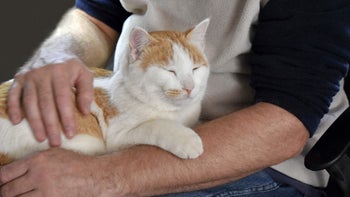
Gabapentin for Cats: A Common Option for Pain and Anxiety
Key takeaways:
Gabapentin is a pain medication that also has sedative effects. Because of its sedative effects, it’s often prescribed to manage anxiety before a stressful event.
The most common side effects of gabapentin include sedation and difficulty with balance and coordination. These effects typically wear off in 8 to 12 hours.
Your veterinarian will determine the best dosage of gabapentin for your cat. This will depend on their weight and what your cat is treated for.
Table of contents

It’s no fun when your cat has anxiety, especially when going to the vet. These events can be stressful for both you and your cat. And when your cat is in pain, it’s hard to watch them hurt. In both cases, gabapentin could be a medication option for your cat.
Gabapentin is a medication used to treat pain in cats. It is also used as a sedative to help reduce anxiety during stressful situations, like car travel and vet visits. Here’s what you need to know about this common feline medication.
Gabapentin for cats at a glance
Common brand names | Gabapentin (Neurontin) |
What it treats | Pain, fear, anxiety, stress |
How it comes (forms) | Capsules, compounded liquid or tablets |
Common side effects | Lethargy, sedation, walking and balance issues (ataxia) |
Average cost | $12 for a 30-day supply |
What is gabapentin for cats, and how does it work?
Gabapentin is a type of anti-seizure medicine, antianxiety medication, and nerve pain reducer.
Save on the top 10 pet medications
Save big on common pet medications like Fluoxetine and Levetiracetam at your local pharmacy.

GoodRx is NOT insurance. GoodRx Health information and resources are reviewed by our editorial staff with medical and healthcare policy and pricing experience. See our editorial policy for more detail. We also provide access to services offered by GoodRx and our partners when we think these services might be useful to our visitors. We may receive compensation when a user decides to leverage these services, but making them available does not influence the medical content our editorial staff provides.
The way that gabapentin works is not fully understood. But it is thought to reduce calcium flow into nerve cells. This reduces the release of neurotransmitters that cause excitement or pain in nerve cells. As a result, it’s believed that this leads to less pain, sedation, and anti-seizure effects.
Gabapentin is FDA approved for use in people but not in pets. In cats, gabapentin use is “off-label,” but a veterinarian can still prescribe it. This is very common in veterinary medicine.
Although gabapentin is not federally controlled, it is a schedule 5 controlled substance in some states. Depending on what state you live in, there may be restrictions and limitations on how your vet can prescribe and refill gabapentin for your cat.
What is gabapentin used for in cats?
In cats, gabapentin is commonly used as a pain medication. Clinical research shows it is also very useful in cats to reduce fear and anxiety with stressful situations. This may include:
Car or plane travel
Veterinary exam visits
Grooming visits
Other expected events, like fireworks, construction, or parties
When treating pain in cats, gabapentin is more commonly used for chronic pain, such as arthritis or back pain. Research does not support gabapentin being very effective for acute (sudden) pain in cats.
How to calm your cat before the vet: Veterinary visits can be a challenge, especially if your pet isn’t used to unfamiliar environments. Learn how to help reduce their stress before an appointment.
Is your cat in pain? Learn the warning signs that your cat is in pain and when you should take your pet to the vet.
Managing cat anxiety: If your cat experiences anxiety over an extended period of time, consider these treatments, from supplements to natural remedies.
Gabapentin does have some anti-seizure effects, but it is not considered a first-choice option for seizure disorders in cats. Other medications are typically prescribed first to control seizures. Gabapentin may be used in cats as add-on therapy.
How is gabapentin dosed and given to cats?
Gabapentin dosage depends on your cat’s weight and response to the medicine.
Dosage for pain in cats
Most cats will not need a dose higher than 50 mg when used for pain. It’s important to consult your veterinarian to figure out the proper dosage. Gabapentin can be used every 8 to 12 hours for pain management.
Read more like this
Explore these related articles, suggested for readers like you.
Dosage for anxiety in cats
For sedation and to manage anxiety, gabapentin doses in cats may be higher than when used for pain. The dose range for most cats is 50 mg to 200 mg and rarely exceeds 200 mg. When used before a stressful event, gabapentin should be given at least 2 to 3 hours before the event. Some vets will advise giving a dose the night before as well.
Available forms of gabapentin for cats
Gabapentin comes in a capsule form. The 100 mg size is typically prescribed for cats. Because a dose of less than 100 mg is common for cats, the capsules are often opened. Portions of the powder inside are estimated for dose and mixed with canned or soft food.
The commercially available liquid form of gabapentin contains xylitol, an artificial sweetener. Xylitol is toxic to dogs but has not shown the same risks in cats. Even so, many vets will not prescribe this form to reduce any possible risk to your cat or dog at home.
If gabapentin capsules do not work well for your cat, your veterinarian can help you get it compounded into another form. This can include a liquid with flavoring that’s safe for cats or small tablets.
How to give cats gabapentin
Gabapentin capsules are usually best given inside soft food or a treat. This reduces the risk they get stuck in your cat’s mouth or throat. You can also give a small amount of water after giving a capsule directly by mouth.
What are the common side effects of gabapentin in cats?
The most common side effects of gabapentin for cats include:
Lethargy
Sedation
Difficulties with walking and balance (ataxia)
You may expect or even desire these effects when using gabapentin as a sedative for your cat. But these side effects can be problematic with daily use for pain or seizure disorders. Your vet can work with you to alter the dose or form of gabapentin to reduce these effects in cats.
Some cats may experience excessive drooling, vomiting, or diarrhea with gabapentin. This is uncommon, but you may see it more with higher doses.
What are the most serious risks of gabapentin for cats?
Serious risks of gabapentin for felines are uncommon. Higher doses may cause more pronounced lethargy and walking or balance issues.
Gabapentin should be used cautiously in cats with significant liver or kidney disease, since it may take longer for the effects to wear off.
Avoid giving gabapentin to pregnant or nursing cats. Gabapentin can cross the placenta and enter the mother’s milk.
Does gabapentin interact with any other cat medications?
Gabapentin can have interactions with several other medications. This does not mean they cannot be used together in your cat. But they should be used cautiously under veterinary direction.
Medicines that may interact with gabapentin in cats include:
Products that contain aluminum, magnesium, or calcium: This can include antacids. If using antacids, separate the time your cat takes them from gabapentin by at least 2 hours.
Central nervous system depressants: Examples include mirtazapine (Remeron), phenobarbital, and CBD (cannabidiol).
Opioid pain medications: Examples include buprenorphine (Buprenex) and tramadol.
Make sure your veterinarian knows about other medications your cat is taking if gabapentin is prescribed.
What should you do if your cat misses a dose of gabapentin?
If you miss giving your cat a dose of gabapentin, it is best to wait until the next dose is due. Giving another dose too soon may increase the risk for too much sedation.
Frequently asked questions
If your cat has been taking gabapentin regularly for a while, then you should not suddenly stop giving it to your cat. In cats who have been taking gabapentin long term, suddenly stopping the medication can lead to seizures. If you need to stop the gabapentin, you should gradually taper your cat off the medication. Ask your veterinarian for a safe way to do this.
It depends on your cat. But when you’re using gabapentin to reduce anxiety before a stressful event, most veterinarians recommend giving it to your cat 90 minutes before their appointment. Other veterinarians suggest giving gabapentin 2 to 3 hours to kick in before a stressful event.
The effects of gabapentin typically wear off after 8 to 12 hours. In cats with kidney or liver disease, it can take longer for the effects to wear off.
The bottom line
Gabapentin is a medication commonly used in cats for long-term pain relief. It is also used to manage your cat’s fear and anxiety during stressful events. Side effects are typically limited to temporary sedation and problems with balance. It is best to work with your veterinarian to find the right dose for your cat depending on its intended use.
Why trust our experts?



References
Brooks, W. (2021). Gabapentin (neurontin). Veterinary Partner.
Capuzzi, J. (2023). Medicine to ease the feline mind. DVM360.
Dehaney, R. (2023). Using gabapentin to reduce feline stress. DVM360.
Jerzsele, Á., et al. (2018). Effects of p.o. administered xylitol in cats. Journal of Veterinary Pharmacology and Therapeutics.
McNerney, T. (2019). Heading off chronic pain with analgesics. DVM360.
Panktraz, K. E., et al. (2017). Use of single-dose oral gabapentin to attenuate fear responses in cage-trap confined community cats: A double-blind, placebo-controlled field trial. Journal of Feline Medicine and Surgery.
Parent, J. (2010). Work-up, therapy and complications of seizures in cats. World Small Animal Veterinary Association World Congress Proceedings.
Shafford, H. L. (2016). Serenity now: Practical sedation options for cats & dogs. Veterinary Anesthesia Specialists.
U.S. Food and Drug Administration. (2021). Paws off xylitol; it’s dangerous for dogs.
van Haaften, K. A., et al. (2017). Effects of a single preappointment dose of gabapentin on signs of stress in cats during transportation and veterinary examination. Journal of the American Veterinary Medical Association.


























